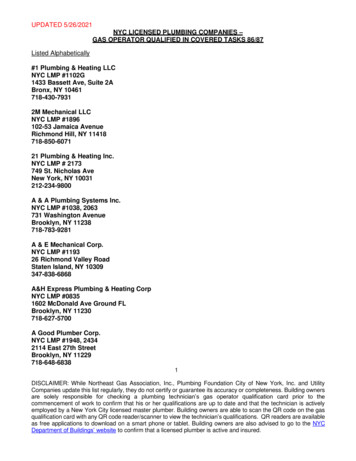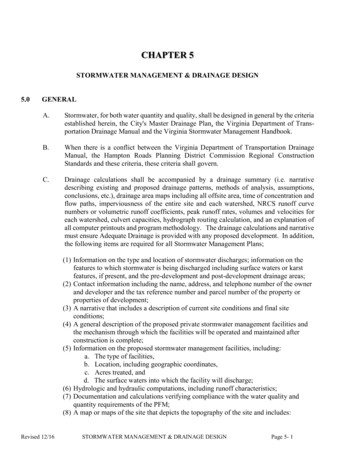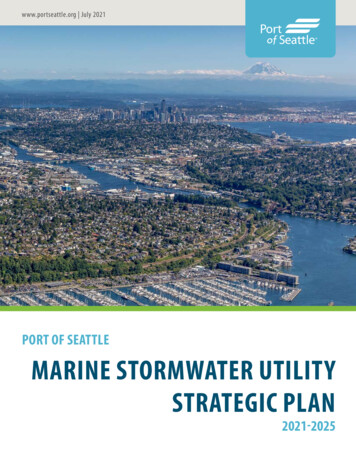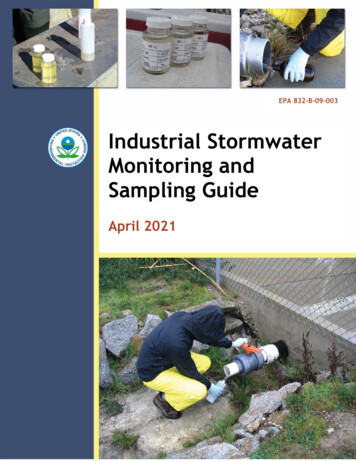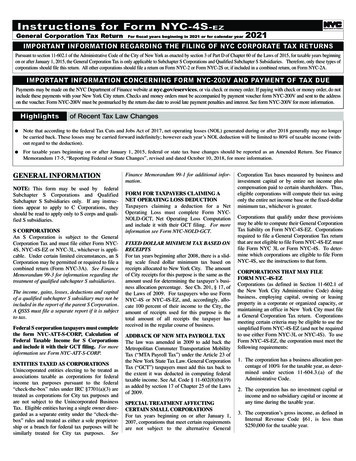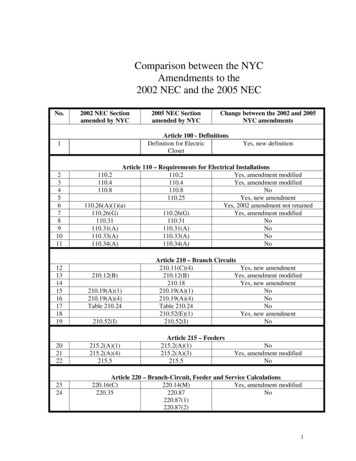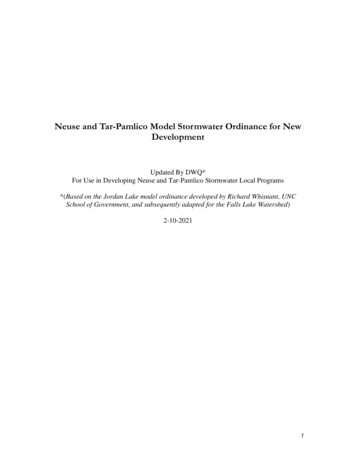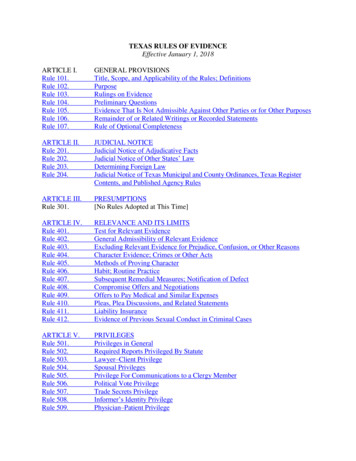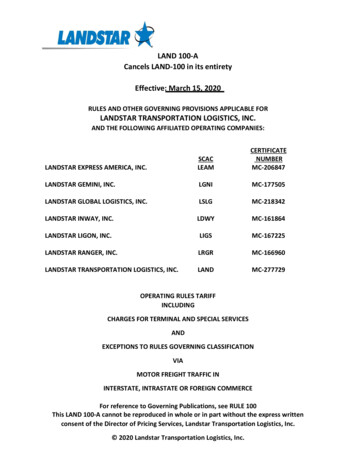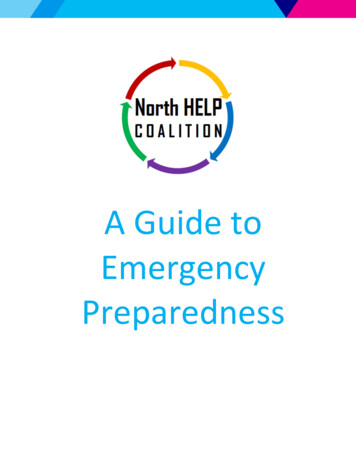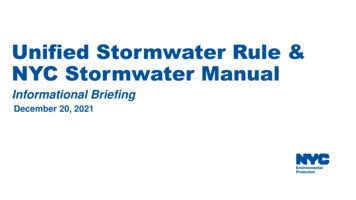
Transcription
Unified Stormwater Rule &NYC Stormwater ManualInformational BriefingDecember 20, 2021
Welcome – Mikelle AdgateAgenda Unified Stormwater Rule RegulatoryContext– Pinar Balci What’s Changing? - Peg O’ConnorMikelle AdgateSENIOR ADVISOR, PUBLIC AFFAIRS & COMMUNICATIONS NYC Stormwater Manual – Melissa Enoch Manual Appendices - Gareth King Next Steps – Mikelle Adgate
USWRRegulatoryContextPinar BalciASSISTANT COMMISSIONER, ENVIRONMENTAL PLANNING& ANALYSIS
Regulatory Context – Today’s RulesStormwater Construction Permit Applies to MS4 projects that disturb 1 acre ormore of soil Must comply with NYC StormwaterDesign Manual Manage volume of 1.5-inch rainfall eventSite/House Connection Proposal Release rate and volume requirements based onallowable flow for site Additional release rate requirementsfor CSS projects, per 2012 Stormwater Rule Maximum discharge rate, often 0.25 cfs while rainfallevent is being managed Must comply with NYCDEP 2012 SW Rule andguidelines for detention facility design4
USWR Overview Aligns the RCNY Chapter 31 stormwaterquantity and flow rate requirements with theRCNY Chapter 19.1 Construction/PostConstruction permitting program water qualityrequirements. Lowers DEP’s current lot size threshold for theconstruction/post-construction stormwater permittingprogram from one-acre (43,560 square feet) to 20,000square feet (sf) and adding the creation of 5,000 SF ofimpervious area as an additional trigger. Extends DEP’s permitting, inspection andenforcement program for development projectsfrom only MS4 areas to CSS areas, includingrequirements, standards and penalties forconstruction and post-constructionstormwater controls. Encourages development projects greater than orequal to 20,000 sf to use green infrastructure tomeet requirements of both Chapter 31 and 19.1. Updates sewer connection volume requirementsand maximum stormwater release rates for bothCSS and MS4 areas.5 Allows greater flexibility in stormwater managementdesign options, while simplifying the rules andmaking them consistent across the city, regardless ofthe borough. References the new NYC Stormwater Manual in bothChapter 31 and 19.1 for applicable stormwatertechnical requirements, including StormwaterManagement Practice Hierarchies and StormwaterManagement Practice Selection Checklists.
What’sChanging?Peg O’ConnorDIRECTOR, STORMWATER CONSTRUCTION PERMITTING
Unified Stormwater Rule:Stormwater Construction Permit Applies to CSS/MS4 projects that disturb 20,000 sf ormore of soil, OR add 5,000 sf or more ofnew impervious surface Must comply with Unified Stormwater Rule Manage volume of 1.5-inch rainfall eventSite/House Connection Proposal Applies to CSS/MS4 projects that require a site/house connectionproposal Must comply with Unified Stormwater Rule Provide specified detention volume and maximum-release ratebased on project type: 7CSS-site: 1.85” volume, greater of 0.1 cfs/acre or 0.046 cfsCSS-house: 1.50” volume, greater of 0.1 cfs/acre or 0.046 cfsMS4-site: 1.50” volume, greater of 1.0 cfs/acre or 0.046 cfsMS4-house: 1.10” volume, greater of 1.0 cfs/acre or 0.046 cfsGreen infrastructure framework thatsupports application of practices to meet both objectives
What’s Changing?Stormwater Construction Permit Expanded to CSS area projects Reduces soil disturbance threshold from 1 acre to20,000 sf New threshold for 5,000 sf or more of new impervioussurface Creates clear SMP hierarchy for CSS/MS4 areasNew NYC Stormwater ManualReplaces: 2018 NYC MS4 Manual 2012 Stormwater RuleManual 2012 Guidelines for Designof Detention FacilitiesSite/House Connection Proposal Aligns release rate requirementswith Stormwater Construction Permit requirements Simplifies requirements to determine volume and releaserate Provides maximum discharge rate scales by project area Reduces the maximum release rate from sites in all cases Lowers minimum orifice size to 1-inch diameter Defines house connections as 1-3 family (fee simple)homes 20,000 sf8Clear guidance on how green infrastructure volume canbe applied towards multiple goals
USWR Requirements:Stormwater Construction Permit When permit applies, prepare a stormwater pollution prevention plan(SWPPP) that meets up to four requirements, as needed: Erosion and sedimentation (ESC) – to minimize the discharge of pollutantsduring construction activities. Water quality (WQ) – to manage runoff from small, frequent storm events thatcan significantly impact the quality of receiving waters in both MS4 and CSS areas. Runoff reduction (RR) – to maintain a minimum level of runoff reduction during smallstorms to preserve natural hydrologic functions. No-net increase (NNI) – to reduce pollutants of concern in MS4 sewershed areas thatdischarge to an impaired waterbody. Site/House Connection Proposal When permit applies, prepare a site/house connectionproposal that meets the following requirement: 9Sewer operations (Vv) – aims to manage runoff fromlarger storm events to maintain optimal flow rates in theCity’s sewer system and, in turn, improve overall seweroperations. Volume from SWPPP facilities will counttowards this Vv requirement.
Chapter 19.1 Effectiveness (Summary):New 19.1-03 does not apply to:A. MS4 development activity 1 acre1. If NYSDEC issued one of the following prior to 6/1/2019:1) letter of acknowledgment of NOI under NYS CGP or 2)individual SPDES permit for construction activity.2. If DEP issued MS4 SWPPP Acceptance Form within 2years prior to effective date of USWR.B. CSS development activity 1 acre1. If applied to DOB or SBS for construction documentapproval before 3/26/21.C. MS4 and CSS covered development project 1 acre1. not located in a rezoned area: if applied to DOB or SBS forconstruction document approval before effective date ofUSWR.2. located in a rezoned area and developing the site pursuantto the rezoning: if DOB or SBS issued a permit forconstruction of the project before 12/10/2021.10
Chapter 31 Effectiveness (Summary):New § 31-09:Does not apply to any site with a sewer availability certificationissued prior to the effective date of USWR.Except thatDoes apply to any site located in a rezoned area anddeveloping the site pursuant to the rezoning, even if applied foror received certification prior to effective date of USWR.11
Hydrology & Hydraulics forRezoned Areas Projects proposed within areas that have been rezonedrecently require additional assessment. The existing practice is to require a Hydrology andHydraulics (H&H) analysis be complete prior to review. The combined and sanitary sewers in areas that havebeen rezoned may be substantiallyundersized compared to the new proposed densities.12
USWR Requirement ApplicabilityFigure 2.3: for determining applicable requirements of thestormwater construction permit.13Table 2.2: Covered development activities that require the preparation of a SWPPP that onlyincludes erosion and sediment control requirements.
USWR Requirement ApplicabilityFlow diagram #2: for determining applicable requirements of thesite/house connection proposal.14Flow diagram #3: which indicates procedures for the applicable requirements.
USWR Permit Process15Flow diagram #4: inter-relationship betweenthe stormwater construction permit andsite/house connection proposal process, when both areapplicable
USWR PermitProcess16Flow diagram #5: detailed process forstormwater construction permits
NYCStormwaterManualMelissa EnochMANAGING DIRECTOR, GI PLANNING & PARTNERSHIPS
NYC Stormwater Manual Chapters1: Introduction2: Stormwater Management Requirements Stormwater Construction Permit (Chapter 19.1) Site/House Connection Proposal (Chapter 31)3: City Development & Review Requirements Workflow for projects that trigger both Chapter 19.1 & 31 Permits Entire process for Chapter 19.1 Permits4: SMP Selection & Design5: Post-Construction Stormwater Management Requirements6: Right-of-Way Stormwater Management Requirements18
Chapter 4: SMP Function TypesInfiltration Water is captured and infiltrated into theunderlying soils, which is sometimes referred toas exfiltration.Relies on sufficient permeability rates ofunderlying soils. Practices do not use outlet pipes todrain water. Water is captured and evaporated ortranspired back into the atmosphere.Relies on ET occurring between rainfallevents. Practices are usually shallow and haveno or limited ability to infiltrate water.Example: Green roofReuse19 Water passes through a filtration mediato remove various pollutants.Relies on steady flow of water throughthe filtration media. Practices have anoutlet pipe to support filtration.Example: Sand filterExample: Bioretention, no outlet pipeEvapotranspiration Filtration Water is captured and reused for non-irrigation purposes. Relies on continuous reuse of water. Practices can be integrated intoexisting non-potable and non-contact water uses. Example: Reuse in cooling towerDetention Water is temporarily stored andreleased at a lower flow rate.Relies on ability to control release rate.Practices have a controlled-flowdevice, such as an orifice.Example: Detention tank
Chapter 4: Benefits of Function Framework Framework allows a wide range of potentialconfigurations: Practices may change function based on designcomponents (see right)Supports innovative systems, such as hybrid or dualfunctionsPlanter Box ExampleInfiltration Guidance that may be specified by function type: Hierarchy (i.e., retention vs. treatment vs. detention)Sizing (i.e., 100% runoff reduction vs. 40%)Design criteria (i.e., min. infiltration rate or media depth)Components (i.e., no outlet pipes vs. with outlet pipes)Filtration20
Chapter 4: MS4 Area Hierarchy21
Chapter 4: CSS Area Hierarchy22
Chapter 4: ConstraintsSoil constraints – permeability tests indicatethat soil infiltration rates are less than 0.5 in/hr,which limits the use of infiltration practices.Subsurface constraints – boring tests indicatethat the bottom of practice would be less thanthree feet from the groundwater table orbedrock, which limits the use of most practices,except those enclosed in concrete with adequateanchoring as determined by an engineer.Hotspot constraints – land use or soilconditions increase the risk of runoffcontamination, which limits the use of infiltrationpractices, or those without liners. Specific criteriafor demonstrating hotspot constraints areoutlined in Chapter 4.Surface constraints – regulations require theuse of paved surfaces, which limits the use ofvegetated practices. As an example, regulationsfor parking and/or egress requirements.Space constraints – required setbacks fromstructures, utilities, property lines, existing trees,or other site features limits the use of practicesat the ground level. General siting criteria for onsite projects can be found in Appendix C.23
Chapter 4: SizingGeneral steps: Calculate volume of practice Apply volume to applicable criteria Confirm drawdown time is acceptable24
NYCStormwaterManualAppendicesGareth KingCIVIL ENGINEER II, WATER & SEWER OPERATIONS
AppendicesA. SMP Hierarchy ChecklistB. NNI Calculator GuideC. SMP Siting CriteriaD. SMP Sizing ExamplesE. Site Design ExampleF. Controlled-Flow Pump WorkbookG. Detention in Series Workbook and ExamplesH. ROW Guidance Materials26
Appendix F: Controlled Flow Pump Workbook27
Appendix G: Detention in Series Workbook &Examples28
Next StepsMikelle AdgateSENIOR ADVISOR, PUBLIC AFFAIRS & COMMUNICATIONS
Public Briefings and CommentsEventDate/TimeVirtual MeetingInformational Briefing #1December 20, 20214:00PMZoomInformational Briefing #2January 4, 202210:00AMZoomPublic HearingJanuary 10, 202211:00AMMicrosoft TeamsResources1. Unified Stormwater Rule Overview2. Chapter 313. Chapter 19.14. NYC Stormwater Manual30
Questions?Send comments/questions to nycrules@dep.nyc.gov31
Event Date/Time Virtual Meeting Informational Briefing #1 December 20, 2021 4:00PM Zoom Informational Briefing #2 January 4, 2022 10:00AM Zoom Public Hearing January 10, 2022 11:00AM Microsoft Teams Resources 1. Unified Stormwater Rule Overview 2. Chapter 31 3. Chapter 19.1 4. NYC Stormwater Manual
